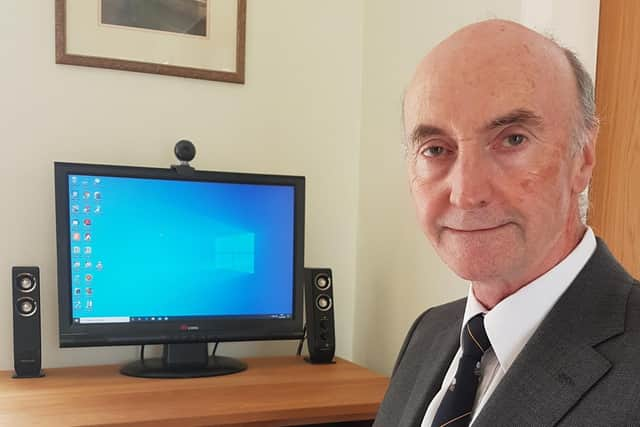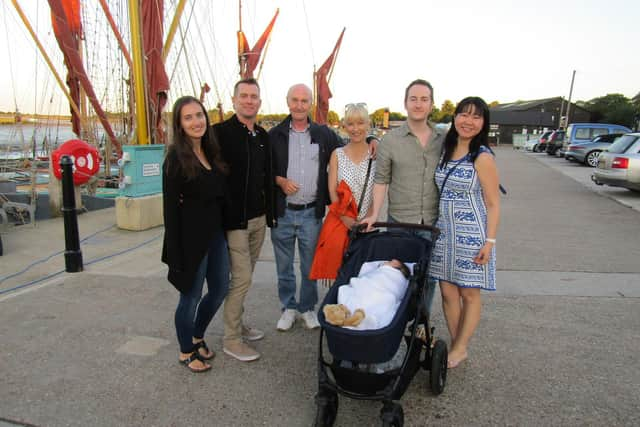Yorkshire man tells of how he blinked one day and 'couldn’t get my eyes to open back up again’
There was nothing unusual about the morning, back in April 2014, when Robert Graham blinked and his eyelids remained closed.
In fact, it was a typical day for the 66-year-old from Bingley.
Advertisement
Hide AdAdvertisement
Hide AdHis morning started in the usual way - boarding a train on his regular commute into Leeds, where he worked as an accountant.


It was a clear spring day when he disembarked and began making his way along Boar Lane in the city. He recalls seeing the sun rising. That’s the last thing he remembers noticing, before he blinked - and then struggled to open his eyelids again.
Robert initially thought it was a temporary reaction to the brightness and shifted into the shade. It eased things slightly, but for the rest of his walk to his offices on The Headrow, he had to manage with sneaking glimpses from the edge of his eyelids and using his hands to feel along the walls lining his familiar route.
“At no point was I totally blind,” he says. “I couldn’t open my eyes but I could sort of twist the corner of my eye open sufficiently to see where I was stood and keep moving along.”
Advertisement
Hide AdAdvertisement
Hide Ad

Inside the office, things were only marginally better, and colleagues stopped to ask Robert if he was okay. “My eyes were twitching and shutting throughout the day without any control. It was very unpleasant,” he recalls.
“Whenever I moved, my eyes would shut. They felt heavy, so I thought it was due to tiredness as it had never happened before.”
The following day, things had eased and Robert dared to think the ordeal may be over. It wasn’t to be. By 10 o’clock, there he was again, struggling to open his eyelids.
“That was a pattern that continued day after day. I’d have to live with the thing from about 10 or 11 o’clock in the morning. It was unpredictable and would be brought on by almost anything.”
Advertisement
Hide AdAdvertisement
Hide AdBrightness or the feeling of air wafting in his eyes would be particularly triggering for Robert, so much so that he tried wearing sunglasses and even tinted goggles to see if it would help. The impact was marginal.
Over the next few months, he found himself in a pattern of walking with his eyes closed before opening them very briefly to get his bearings.
“I could only keep my eyes open for a fraction of a second at a time, enough to see where I was and enable me to walk for the next five seconds with my eyes closed. But one day I collided with a lamp post which made me realise that I couldn’t continue with this bizarre routine and needed to take action.”
Robert went to see his local GP, who thought it could be dry eyes and gave him drops. They didn’t help and he asked to be referred to a specialist.
Advertisement
Hide AdAdvertisement
Hide AdRobert explains: “The specialist thought I had inflammation of the eyes and set about treating that. Although there was a very slight improvement, there was no change in my overall condition.”
By this point, the eye condition was having a major impact on Robert’s life. He had to stop driving and couldn’t read, something he had always enjoyed. At work, he would conduct meetings with his eyes closed.
“I would explain that I was listening even if my eyes were closed – I didn’t want people to think I was being rude or was disinterested. If I needed to say something, I would briefly open my eyes.”
Eventually, Robert was referred to Professor Bernie Chang at Optegra Eye Hospital Yorkshire, who is also President of the Royal College of Ophthalmologists.
Advertisement
Hide AdAdvertisement
Hide AdRobert showed the professor a video he had filmed of what was happening to his eyes and questioned, from his own research, whether it could be blepharospasm - the abnormal contraction of the eyelid muscles.
Professor Chang agreed and suggested that he started botox injections to help.
He says: “From the first day he gave me the botox, I never had another shutdown. It doesn’t mean to say it’s gone away.
“There’s a feeling that invariably twists away in the back of my eye but it doesn’t force me to shut my eyes any longer. It tells me I should be shutting my eyes but there’s enough control now from the muscles to counteract that.
Advertisement
Hide AdAdvertisement
Hide Ad“It is troublesome but it’s moved from being a total disability, where I would say I was functionally blind for the thick end of a year, to after the botox the whole thing just being a big irritation…It gets worse from time to time but I’ve never ever had a shutdown [since the botox].
“My eyes sometimes feel a bit heavy and sometimes I feel I need to blink more than I ought to. It’s troublesome but not really disabling.”
Alongside the botox injections, Robert has tried acupuncture and hypnotism.
“I discovered that the more you fight the eyes, and try to force them open, the tighter they clamp shut,” he says.
Advertisement
Hide AdAdvertisement
Hide Ad“The best course of action is to relax the facial muscles – this is what the alternative therapies taught me to do.
“Using these techniques alongside the botox means I can relax my whole face and therefore control my eye movements. I am learning to manage my condition.”
Professor Bernie Chang explains that blepharospasm “is where the muscles that close your eyes contract involuntarily.
“The exact cause of this condition is not known but there is a fundamental problem with transmission of messages to the eyelid muscles making them “hyperactive” and they go into spasm.
Advertisement
Hide AdAdvertisement
Hide Ad“The botulinum toxin (botox) injections need to target specific areas to allow the eyes to open and to reduce the spasms so they stay open. There are other treatments but this is the main one with a lower risk of complications.
“Mr Graham has to come in every few months, but the injections are working and he has a degree of control over his eyelids again.”
